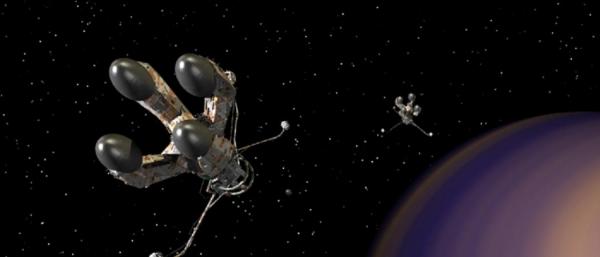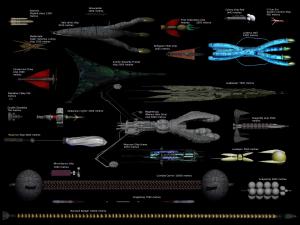BY LETTER
Halo Drive
Technology > Application > Transportation > Interstellar Transport
Technology > Application > Transportation > Propulsion Technology
Technology > Technology Type or Material > Space-Time Engineering
Technology > Technology Levels > Transapientech / Godtech / Clarketech
Technology > Application > Transportation > Propulsion Technology
Technology > Technology Type or Material > Space-Time Engineering
Technology > Technology Levels > Transapientech / Godtech / Clarketech
Reactionless vessels hauled through space by a cloud of void bubbles | |
 Image from Juan Ochoa | |
| A Halo Ship of the Mutual Progress association, showing the massive gravitomagnetic coupling pods at the front of the ship | |
Usually, S:5 bubble drive ships have many hundreds to several million drive bubbles around a fairly conventional deep space hull. Rather than coupling the bubbles to the hull solely by magnetics, the intense gravity gradient of the bubbles is also used to move the hull around. This has the large benefit of allowing the acceleration effects of the drive to be largely negated. This means that S:5 bubble drive ships can accelerate much, much harder than any previous technology. The hulls of these ships are equipped with the most advanced passive and active defenses available, and have the added defensive ability of the intense gravity fields of the drive bubbles to call on. The use of void bubbles this way is popularly called Halo Drive, and ships using this method of locomotion are called Halo Ships. The reason for this is the blurry ring of distortion created by the myriad of drive bubbles around such vessels, an effect which can be quite difficult to detect, especially at high velocities.
 Image from Anders Sandberg | |
| Halo drive patrol ship belonging to the Rikendra 43 clade of the Orion Federation. The ship is equipped with advanced nano stealth systems (deactivated in the picture) and mainly intended to patrol the outer regions of the Rikenda 43 controlled systems on the lookout for ferals. Length 400 meters, total mass 54 million kilograms. Crew: one drive AI, two tactics caste, one engineering caste. | |
Subtypes of observed Halo Drive Ships
Class I: A Class I Halo drive deploys a cloud of drive nodes around the actual craft being propelled and uses magnetic coupling to attach the drive nodes to the vessel itself. When the nodes move, the vessel is pulled across space. Generally a greater number of nodes are employed and higher accelerations are possible. However, as with the Displacement drive a Class I configured Halo drive does not protect against acceleration forces.Class II: A Class II Halo drive employs an even greater number of drive nodes than a Class I drive and utilizes more massive nodes than either a Displacement or Class I drive. Like the Class I system a Class II drive links its drive nodes to the associated craft using magnetic fields. However, it also links the nodes gravitationally, positioning them much closer to the hull of the ship than is normally done in a Class I configuration and employing more dynamic control systems. As the Halo vessel is accelerated by its associated drive nodes it is also moved into closer proximity with them, effectively balancing the inertial acceleration of the moving nodes with the gravitational acceleration created by their mass. In effect the ship 'falls' toward the drive nodes, which move away from the ship at an equal or near equal rate of acceleration. This permits the passengers and cargo aboard a Class II Halo vessel to experience only moderate accelerations, or even free-fall conditions, even if the ship is accelerating at tens or hundreds of gravities.
Halo drives decelerate their associated vessels by reconfiguring their drive nodes from the front to the rear of the ship and reversing the process used to provide acceleration.
It appears that only Fifth Singularity minds and above can create practical Halo drive systems. A spacecraft equipped with a Halo Drive can only be controlled by an entity of at least the Second Singularity (often a so-called dedicated transvot, which itself controls the many drive nodes, each containing a First singularity entity).
There is also some evidence that suggests that Fifth Singularity drive nodes can be deactivated in a semi-controlled manner sufficient to permit the survival and reuse of the node mechanisms, or even hardened instrument packages carried within the Void metric.
S:5 bubble drive ships have effective ranges of at least 5000 light years, and top speeds limited only by the available matter inside the bubbles for fuel. Again, in practical usage such ships rarely exceed 0.84c on routine trips, to preserve fuel mass and extend the lifetime of the drive bubbles. For fast trips, top speeds of 0.99c are not unheard of, and the extremely advanced shielding allows very long cruises at such speeds if desired.
Related Articles
Appears in Topics
| Interstellar Transport | Propulsion Technology | Space-Time Engineering |
| Transapientech / Godtech / Clarketech |
Development Notes
Text by Todd Drashner, Adam Getchell
Mark Mcamuk, Chris Shaeffer
Initially published on 09 December 2008.
Mark Mcamuk, Chris Shaeffer
Initially published on 09 December 2008.







